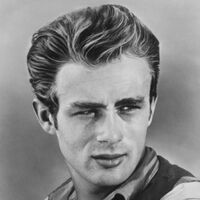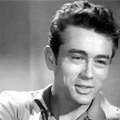James Dean

Relevance
The video for Suedehead was filmed in Dean's hometown - Fairmount, Indiana.
The cover star of Bigmouth Strikes Again.
Morrissey wrote James Dean Is Not Dead in 1981.
From The Morrissey Collection - Smash Hits (June 21 - July 4, 1984):
"I saw Rebel Without a Cause quite by accident when I was about 6. I was entirely enveloped. I did research about him and it was like unearthing Tutankhamun's tomb. His entire life seemed so magnificently perfect. What he did on film didn't stir me that much but as a person he was immensely valuable. Everything from his birth in a farming town to coming to New York, breaking into film and finding he didn't really want it when he had enormous success. At school it was an absolute drawback because nobody really cared about him. If they did, it was only in a synthetic rock and roll way. Nobody had a passion for him as I did — for that constant uneasiness with life. Even though he was making enormous strides with his craft, he was still incredibly miserable and obviously doomed. Which is exactly the quality Oscar Wilde had. That kind of mystical knowledge that there is something incredibly black around the corner. People who feel this are quite special and always end up in quite a mangled mess."
Image used as a backdrop circa 2007-2008:
A childhood photo of Dean was used on tour passes & drum header in 2012:
A Morrissey & Dean montage was used as a backdrop in 2019, using a still from Rebel Without A Cause (1955). Morrissey replaces Corey Allen in the image:
Image used as backdrop during "We Hate It When Our Friends Become Successful" in 2022. James Dean on The Stu Erwin Show (S2.E8 Jackie Knows All, Dec. 7, 1951).
Image used as backdrop during "The Boy Racer" in 2024. James Dean on "The Unlighted Road” (1955).
Image used as backdrop during "Some Say I Got Devil" in 2019.
Image used on a Crew shirt - observed on 3rd leg of 2022 tour (at The Magnolia):
-
Miro Lagioia: drum technician (2022) source
Image featured on 2018 tour poster:
Mentioned In
- Meat Is Murder! - Smash Hits (January 31, 1985)
- All Men Have Secrets... - Hot Press (May 4, 1984)
- The Morrissey Collection - Smash Hits (June 21 - July 4, 1984)
- Morrissey, The Face Interview - The Face (July, 1984)
- Bigmouth Strikes Again (single)
- Morrissey, the Ever Marketable - Los Angeles Times (March 27, 1994)
- Tour Of The Tormentors MMVI 2006-2007 Pre-show Tracks
- Greatest Hits Tour 2007-2008 Pre-show Tracks
- All The Best Ones Are Dead - true-to-you.net (March 18, 2016)
- The Interview. A LARKS' TONGUE IN APRIL. - Morrissey Central (June 24, 2019)
- In Memory Of: list of those depicted (December 31, 2024)
Wikipedia Information
 |
James Byron Dean (February 8, 1931 – September 30, 1955) was an American actor. He became one of the most influential figures in Hollywood in the 1950s, despite a career that lasted only five years. His impact on cinema and popular culture was profound, even though he appeared in just three major films. Rebel Without a Cause (1955), in which he portrayed a disillusioned and rebellious teenager, East of Eden (1955), which showcased his intense emotional range, and Giant (1956), a sprawling drama, have been preserved in the United States National Film Registry by the Library of Congress for their "cultural, historical, or aesthetic significance". He was killed in a car accident at the age of 24 in 1955, leaving him a lasting symbol of rebellion, youthful defiance, and the restless spirit. Dean was the first actor to receive a posthumous Academy Award nomination for Best Actor for his role in East of Eden. The following year, he earned a second nomination for his performance in Giant, making him the only actor to receive two posthumous acting nominations. In 1999, he was honored by the American Film Institute, being ranked as the 18th greatest male film star from Golden Age Hollywood on their "AFI's 100 Years...100 Stars" list. Time magazine recognized Dean as one of the "All-Time Most Influential Fashion Icons." Dean's film roles and style had a strong impact on Hollywood, capturing the spirit of 1950s youth and creating an enduring legacy that shaped American pop culture and defined rebellious, countercultural attitudes for generations.















